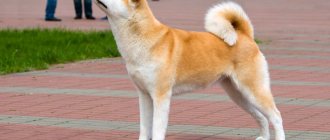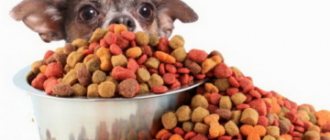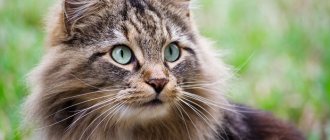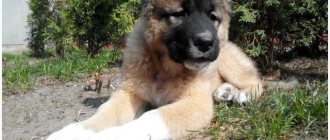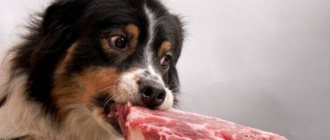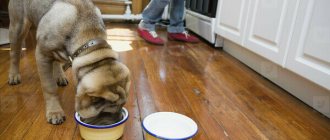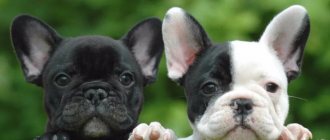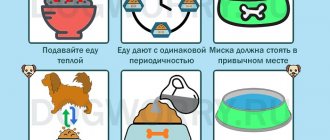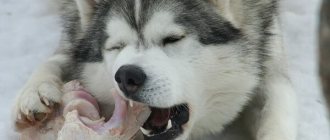Feeding characteristics of Akita Inu
The breed has been bred locally for a long time, without leaving Japan. This formed certain food preferences, developing a habit of a certain type of protein food. In this regard, the owners of Akita Inu puppies are faced with a rather serious choice: cook their own food or use ready-made food.
Regarding the Japanese breed, breeders are quite unanimous - it is better to feed Akita Inu with ready-made food, since preparing natural food is very difficult. In addition, representatives of the breed are very prone to allergies, which can manifest themselves both to chicken and to other types of meat, which should form the basis of the dog’s feeding.
How often do you feed your pet?
How many times should you feed your Akita Inu puppy? This is where disagreements arise. Some breeders insist that the dog must be switched to two meals a day by six months. The latter adhere to the fact that the animal is transferred to two meals a day no earlier than nine months of age. Let's consider both schemes.
According to the first, feeding the puppy is carried out as follows:
- from two to three months - four times a day;
- from three to six - three times a day;
- from six months - 2 times a day.
The second scheme is more complex. As follows:
- from two to three months - five times a day;
- from three to five - four times a day;
- from five to nine - three times a day;
- from nine months - twice a day.
Adult dogs, as stated above, are fed twice a day.
Feeding dry food
The main requirement for the composition of dry food:
- lack of vegetable protein – soy (not digestible by the breed);
- no chicken;
- absence of corn and wheat, orientation to fig.
When choosing food, you need to focus only on premium and super premium classes. Suitable food labeled:
- “natural” - contains only natural ingredients;
- “holistic” - suitable for dogs prone to allergies;
- “human grade” - the marking means that it is made according to human nutrition standards.
Feed comparison
ACANA Wild Coast
Universal food for all breeds and ages. Rich in complete fish protein (50% fish). Contains low-glycemic cut oats, which help regulate blood sugar levels and prevent the development of obesity.
DUKE'S FARM grain-free with lamb
The absence of grains will help avoid allergies in your pet. During production, a special technology is used to process the granules with steam, which allows you to preserve all minerals and vitamins. Contains: high protein content, prebiotics MOS and FOS, bone meal. Does not contain soy.
DUKE'S FARM with venison
Akita Inu digest meat from wild animals well. This brand's grain-free food contains dietary protein, prebiotics, powerful antioxidant mulberries, salmon and omega-3 fatty acids.
ROYAL FARM sensitive with salmon
Designed for dogs with sensitive digestion. Does not contain soy, millet, preservatives or dyes. Omega-3 and omega fatty acids will provide the dog's coat and skin with proper care.
We also performed a detailed analysis of the following feeds: Proplan, Monje, Dog Chow, Brit.
This is how the owner feeds the Akita food with apples, although they must be given separately so as not to cause fermentation in the animal’s stomach.
When to change food
- changes in the physiological state of the dog: growing up, pregnancy, lactation, illness;
- there are signs that the food has been selected incorrectly: the fur is shedding and looks dull, claws are peeling and breaking, bald spots have appeared;
- allergic reaction: the dog is constantly itching, severe scratching on the skin, rash, “running eyes.” Such severe manifestations require immediate contact with a veterinarian and discontinuation of food;
- The dog has seriously gained weight. It is worth reducing the serving size.
In any of the above cases, it is better to contact a specialist so as not to waste time and not undermine the health of your pet.
Feeding Akita Inu with ready-made dry food
In this case, it is much easier to dose the food; manufacturers have already taken care of its balance. However, this issue also has its pitfalls. The thing is that most ready-made dry food is not suitable for dogs of this breed, since they contain soy. The Akita's body absorbs it very poorly. And, in addition, some additives can cause severe allergies in the animal.
Food for dogs of this breed must simultaneously include several natural ingredients - fish, meat and bone meal. Only in this way will the pet be provided with everything necessary.
When making your own choice, you need to take into account that only premium and super premium food, which can be purchased exclusively in specialized stores, is suitable for feeding your Akita.
It is worth paying attention to the packaging, if the word natural is indicated, then we are talking about natural products, holistic - the food is suitable for dogs suffering from food intolerance (also an excellent option for pets with allergies) or human-grade - in this case all ingredients are suitable for human food. All of these foods are suitable for feeding Akita.
If possible, then to be more confident in the correct choice, it is worth consulting with the breeders of this breed.
Natural diet
Creating a natural nutrition plan for Akita Inu usually causes difficulties for inexperienced dog breeders. However, if you decide to feed the animal with natural products, you must follow the rules:
- the diet should consist of three main components: meat, vegetables and fermented milk products (fat content up to 10%);
- percentage: 50% meat and 40% dairy products. About 15% are vegetables;
- Akita Inu's diet may include beef and wild animal meat;
- the meat is given raw, frozen to get rid of parasites;
- offal: liver, kidneys, heart, tripe;
- vegetables are given fresh: carrots, pumpkin, zucchini. Hard tinder on a grater. If an Akita Inu refuses vegetables, they are replaced with bran;
- fruits are given raw: apples, bananas, pears, berries, melon;
- The breed does not need a large amount of cereals. They mainly use rice, which is a small addition to meat (no more than 10% of the serving);
- twice a week the dog is given fish, preferably sea fish, boiled and boneless, and seafood.
Sample menu for the week
| Day of the week | Diet |
| Monday |
|
| Tuesday |
|
| Wednesday |
|
| Thursday |
|
| Friday |
|
| Saturday |
|
| Sunday |
|
Here is a good video about the diet of an Akita Inu, like a real Japanese!
You can give your dog pieces of fruit every day.
Feeding the Akita Inu with natural food
The oldest breed, which the Japanese classified as sacred animals, is the pride of the state, and, above all, belongs to the hunting breeds. Possessing a muscular, strong body, the Akita participated in hunting large animals. Most of these breeds eat more meat, but this is not the case with the Akita Inu.
In their homeland, the diet of such dogs consists mainly of fish, seafood and rice. It also includes salads from kelp and other algae, fruits, and vegetables. This food is very light, nutritious and provides the animal with everything it needs.
That is why, once outside their country and starting to eat completely different food that is unusual for the stomach, many pets of this breed have an allergic reaction. It is directly related to the high content of animal protein in the foods consumed.
The following foods are allergenic for pets:
- poultry meat - chicken, goose, turkey;
- beef and veal;
- high fat dairy products;
- corn;
- wheat and oatmeal.
In this case, it turns out that the food familiar to other dogs is not suitable for the Akita Inu, and as for the diet suitable for it, it causes certain difficulties for the owners. Of course, dogs living outside their country are gradually adapting to a new diet, but some of their features should still be taken into account.
It is best if the Akita's diet consists of several basic products - meat, fish and offal. Moreover, fish must be an obligatory component; this is due to their island habitat and is already a genetic feature.
It would be a good idea to add some seaweed to your beloved pet’s daily menu, in tablet form. The iodine they contain is necessary for the normal development of the animal.
Adult representatives of this breed are fed twice a day - morning and evening. The animal's diet should include the following products:
- Fermented milk - curdled milk, cottage cheese, bifidok, kefir, natural yoghurts.
- Unsalted cheeses.
- Boiled eggs, no more than two per week.
- Meat that is given raw, but previously kept in the freezer, or boiled until half cooked. Rabbit meat, lean lamb, and horse meat are suitable. If the dog does not have allergies, then beef, veal, turkey are suitable; chicken should be given less often.
Akita Inu tolerate wild meat very well - elk, venison, and roe deer meat.
- Fish – served at least twice a week, even if the dog doesn’t really like it. It is better to give preference to low-fat sea fish; you can give it after freezing, boiling it, or dousing it with boiling water. Bones must be removed without fail, especially when it comes to feeding a puppy. The portion must be calculated in such a way that the amount of fish is double the amount of meat. A good supplement for your pet would be fish, ground together with bones in a blender or meat grinder - fish bones are an excellent source of calcium. Boiled bull calves are a good treat for Akita Inu - such food is cheap, healthy for the dog, and they also really like it.
- By-products - give preference to nutritious products from this category; liver, heart, kidneys, and lung are suitable. They must be cooked for a long time before serving. You should not feed pork by-products, they contain too much fat.
- Vegetables - carrots, zucchini, onions, eggplants, pumpkin. Sometimes it is allowed to be given raw, but more often it is worth boiling.
- Fruits - (given from 4 months of age), apples (preferably green with peel), bananas, melon, pears are suitable. Almost all pets love persimmon, but it can weaken the stomach, so it should be given in very moderate quantities. It is recommended to avoid grapes, as they can provoke fermentation processes in the intestines. All berries are suitable except blackberries.
- Porridge – among the cereals suitable for feeding the Akita are buckwheat, rice, and millet.
It is recommended to season vegetables and cereals with vegetable oil (sunflower, corn, olive, flaxseed). You should not experiment with the Akita Inu’s diet and often include new foods in the menu.
What to feed a puppy
Feeding a small Akita Inu is a challenging task. The breed is very sensitive to mistakes in nutrition, and the puppy’s fragile body must receive everything it needs during a period of intensive growth.
| Age (in months) | Diet |
| Up to 1 |
|
| 1-2 |
|
| 2-3 |
|
| 3-6 |
|
| 6-8 |
|
| From 8 |
|
Akita Inu puppies, even at one month of age, are already quite large - the approximate weight of such a baby is 3-4 kg, so the portion size will be quite large.
- for a one-month-old puppy weighing 3.5 kg you will need about 300 grams of food;
- for a four-month old - about 800 grams per day;
- by 8 months the portion will be about 1 kg per day.
The dog's menu will also change depending on age.
| Age | Menu |
| Up to a month |
|
| 1-2 |
|
| 2-3 |
|
| 3-6 |
|
| 6-8 |
|
Photo: wikimedia.org
Sample diet for a week
Based on the needs of the Akita Inu, we can offer the following approximate pet diet for a week:
| Day of the week | Feeding time | Diet |
| Monday | Morning evening |
Fruits during the day |
| Tuesday | Morning evening |
Fruits during the day |
| Wednesday | Morning evening |
Fruits during the day |
| Thursday | Morning evening |
Fruits during the day |
| Friday | Morning evening |
Fruits during the day |
| Saturday | Morning evening |
Fruits during the day |
| Sunday | Morning evening |
Fruits during the day |
What to feed an adult Akita Inu
The serving size of an adult dog can be determined by the formula: N*0.035, where N is the weight of the animal. Then this figure must be divided by the number of feedings, that is, by 2. Example: an adult dog weighs 30 kg, which means 30*0.035/2= 525 grams. At each feeding, the dog should receive approximately 525 grams of food.
Due to their sedentary lifestyle, Akita Inu may refuse to eat and not eat for up to two days. There is no need to worry, provided that the dog is cheerful and active and drinks water.
What to feed the American Akita: dry food or natural products?
The American Akita, like any other dog, can be fed dry food or natural products.
If you are a supporter of natural nutrition, the products must be of high quality. In this case, adhere to the following diet composition:
| Products | Percentage of content in the diet |
| Meat | 50% |
| Porridge | 25% |
| Vegetables, mineral supplements, vitamins | 25% |
The amount of food depends on the size of the dog. On average, an adult American Akita should receive the following diet:
| Products | Quantity |
| Meat | 600 - 800 g per day |
| Porridge | 250 - 400 g per day |
| Vegetables | 250 - 400 g per day |
| Eggs | 1 piece per week |
| Feeding | As prescribed by a veterinarian |
Remember that there are foods that should not be given to dogs.
If you feed your dog dry food, the protein content should not be more than 32%. High protein food can cause an allergic reaction in an American Akita.
Vitamins and mineral supplements
Naturally fed animals need additional mineral and vitamin supplements. There are universal complexes, or they can be selected depending on external changes in the dog’s condition, which indicate a lack of one or another element.
8 in 1 Excel Multivitamin Adult
A complex mineral and vitamin supplement that compensates for deficiencies in your pet’s diet and contains: vitamin C, antioxidants and microelements.
AniVital CaniAgil
Designed to protect cartilage and bones of large breeds of dogs and animals with problems with the musculoskeletal system.
8 in 1 Excel Brewer's Yeast
A complex of vitamins that will take care of your pet’s skin and coat, support the immune system and ensure normal metabolism. Contains: brewer's yeast, fish oil, fatty acids.
How to feed an old dog
Upon reaching the age of seven years, you need to reconsider the animal’s diet:
- change ready-made food to one that is intended for older dogs;
- add a vitamin and mineral complex to the natural diet, including glucosamine and polyunsaturated fatty acids.
At this age, the animal should undergo an examination by a specialist, which will reveal the general state of health and understand which organs need additional support.
Feeding after childbirth
The lactating bitch continues to be fed according to the scheme in which she was fed in the second half of pregnancy.
With a ready-made diet, choose a product intended for puppies or that has special labeling.
Natural food should be exclusively fresh. Increase the amount of fruits, dairy products, and add vitamins.
Photo: maxpixel.net
